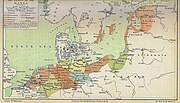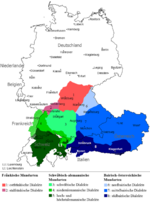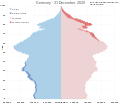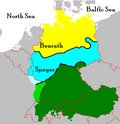the German language area considerably shrank. Large dialects such as the East Pomeranian dialect, most varieties of Silesian German, Prussian dialects and...
24 KB (2,801 words) - 10:06, 15 April 2024
Palatine German (Standard German: Pfälzisch, endonym: Pälzisch) is a group of Rhine Franconian dialects spoken in the Upper Rhine Valley, roughly in the...
8 KB (615 words) - 09:41, 22 June 2024
Low German has not undergone the High German consonant shift, as opposed to Standard High German, which is based on High German dialects. Low German evolved...
133 KB (11,048 words) - 10:35, 7 July 2024
rarely Alemannish (Alemannisch, [alɛˈman(ː)ɪʃ] ), is a group of High German dialects. The name derives from the ancient Germanic tribal confederation known...
15 KB (1,209 words) - 21:39, 17 July 2024
Standard German is based on a combination of Thuringian-Upper Saxon and Upper Franconian dialects, which are Central German and Upper German dialects belonging...
139 KB (13,957 words) - 21:48, 14 July 2024
The High German languages (German: hochdeutsche Mundarten, i.e. High German dialects), or simply High German (Hochdeutsch) – not to be confused with Standard...
10 KB (893 words) - 21:30, 7 July 2024
dialects in other countries is restricted or even endangered. The dialects that comprise Swiss German must not be confused with Swiss Standard German...
69 KB (7,773 words) - 19:19, 18 July 2024
which modern dialect maps are based. For this reason the dialects may be termed "monastery dialects" (German Klosterdialekte). The main dialects, with their...
44 KB (4,423 words) - 15:47, 1 July 2024
and Dresden. Austria High German (Hochdeutsch in Österreich, not to be confused with the Bavarian Austria German dialects) has the same geographic origin...
24 KB (2,363 words) - 03:03, 17 July 2024
Bavarian language (redirect from Austro-Bavarian dialects)
000 sq mi), making it the largest of all German dialects. In 2008, 45 percent of Bavarians claimed to use only dialect in everyday communication. Bavarian...
27 KB (2,198 words) - 18:52, 7 July 2024
dialects, with locally varying degrees of influence of the initial dialects. Swabian can be difficult to understand for speakers of Standard German due...
19 KB (1,403 words) - 17:21, 6 April 2024
more widely understood than other dialects and as a Central German dialect, was felt to be "halfway" between the dialects of the north and south. Luther...
41 KB (3,555 words) - 05:49, 28 May 2024
The official language of Germany is German, with over 95 percent of the country speaking Standard German or a dialect of German as their first language...
14 KB (1,095 words) - 05:15, 30 June 2024
Linguistically, Yiddish is divided in distinct Eastern and Western dialects. While the Western dialects mostly died out in the 19th-century due to Jewish language...
24 KB (2,342 words) - 13:34, 12 May 2024
the first ethnically German families settled in the United States in Jamestown, Virginia, in 1608, the German language, dialects, and different traditions...
55 KB (5,493 words) - 22:44, 12 July 2024
Hessian (German: Hessisch) is a West Central German group of dialects of the German language in the central German state of Hesse. The dialect most similar...
8 KB (771 words) - 03:03, 11 June 2024
Christoph Gottsched) and East Franconian German. East Central German dialects are mainly spoken in Central Germany and parts of Brandenburg, and were formerly...
7 KB (486 words) - 10:13, 15 April 2024
often spoken. Swiss Standard German differs from Swiss German, an umbrella term for the various Alemannic German dialects (in the sense of "traditional...
23 KB (2,296 words) - 00:22, 12 July 2024
Georgian dialects German dialects Malayalam languages Varieties of Malay Connacht Irish, Munster Irish, Ulster Irish Italian dialects Japanese dialects Korean...
60 KB (6,920 words) - 10:29, 1 July 2024
rivers, Low German began to retreat in favour of High German dialects already during Late Medieval times (cf. Wittenberg whose name is Low German but whose...
44 KB (4,986 words) - 20:01, 3 June 2024
Upper German (German: Oberdeutsch [ˈoːbɐdɔʏtʃ] ) is a family of High German dialects spoken primarily in the southern German-speaking area (Sprachraum)...
28 KB (2,893 words) - 12:41, 13 May 2024
Charter. German dialects – some quite distinct from the standard language – are used in everyday speech, especially in rural regions. Many dialects, for example...
218 KB (9,210 words) - 10:37, 17 July 2024
north-eastern Germany as well as by minorities in northern Poland. Together with West Low German dialects, it forms a dialect continuum of the Low German language...
8 KB (815 words) - 09:37, 11 October 2023
Walser German (German: Walserdeutsch) and Walliser German (Walliserdeutsch, locally Wallisertiitsch) are a group of Highest Alemannic dialects spoken...
26 KB (2,202 words) - 00:38, 27 March 2024
East Central dialects are the closest to Standard German (chiefly as a written language) among other German dialects. Modern Standard German thus evolved...
5 KB (297 words) - 19:18, 14 May 2024
"Alsatian German"; Lorraine Franconian: Elsässerdeitsch; French: Alsacien; German: Elsässisch or Elsässerdeutsch) is the group of Alemannic German dialects spoken...
22 KB (1,558 words) - 08:17, 14 June 2024
unaffected. The High German consonant shift altered a number of consonants in the southern German dialects—which includes Standard German, Yiddish, and Luxembourgish—and...
61 KB (6,468 words) - 12:59, 17 July 2024
non-Alemannic German dialects is very limited. Highest Alemannic dialects are spoken in alpine regions of Switzerland: In the Bernese Oberland, in the German-speaking...
3 KB (343 words) - 20:58, 23 April 2022
and to a lesser extent by Italian dialects as well as indigenous languages. High German and Low Saxon/German dialects and Germanic languages are particularly...
19 KB (1,486 words) - 23:52, 5 February 2024
(German: Obersächsisch, pronounced [ˈoːbɐˌzɛksɪʃ]; Upper Saxon: [ɵːb̥oˤˈsɛɡ̊sʃ]) is an East Central German dialect spoken in much of the modern German...
11 KB (1,279 words) - 20:51, 10 May 2024


















